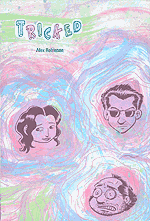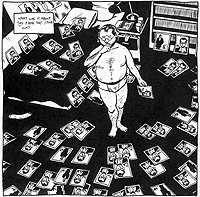
|
Like many such stories, Tricked takes place in a city — though unnamed, it resembles L.A. — allowing it to naturally mix a cross-section of classes and ethnicities. Made up of short, numbered chapters that count down, like a bomb, rather than up, each focuses on one of the book's six major characters, then repeats the cycle. Each set begins with Ray Beam, a burnt-out pop star of ten years ago whose descent from debauched musical godling to weird, unproductive recluse resembles that of Axl Rose. He suddenly seems to find his muse in Lily, a young Hispanic-American woman whose side of the story bookends each chapter cycle. Initially hired as Ray's personal assistant, Lily cautiously allows herself to be wooed by him in spite of such quirks as his carrying around a personal set of flatware to eat with.
A third storyline follows Nick, a forger of famous autographs who plies his trade in a sports memorabilia shop. Not content with merely ripping off customers, he soon finds ways of stealing from his boss, who has ties to organized crime. Eventually Nick crosses paths with Caprice, who works as a waitress and struggles with a self-destructive streak that always seems to lead her to the wrong guys. Meanwhile Phoebe, a teenager from the sticks, arrives at the diner where Caprice works in order to find the owner, her father who left her 15 years earlier. Lastly, and most memorably we have Steve, a creepy weirdo. While displaying an obsessive interest in pop music, particularly the work of Ray Beam, Steve slowly descends further and further into isolated madness.
 Steve contemplates his Ray Beam photo collection in 'Tricked'
Steve contemplates his Ray Beam photo collection in 'Tricked' |
One of the core challenges for these narratives is keeping all of the stories and characters equally compelling. Although Tricked falters in some cases, it still manages to keep itself afloat over some treacherous waters. The Ray Beam and Lily storyline, for example, stretches credulity with its portrait of a decadent rocker, while Lily's character remains an enigma. Robinson does best with the two stories that are at the extremes of personal drama: one quiet and understated, the other of increasingly violent paranoia. Caprice, the cute, funny and loveable waitress with an unfortunate case of low self esteem that results in poor choices of lovers practically walks off the page she seems so real. Equally compelling, Steve the nut, a highly intelligent ego-maniac with deep "anger issues" ("I don't know why, but no one is meaner than a bunch of black teenage girls") will not fail to get a rise out of you. Watching one make the wrong choices is heartbreaking. Watching the other do the same is chilling.
For those who read Clowes' Ice Haven and found the constantly shifting visual styles a distraction, Tricked will be much easier to enjoy. Drawn with pen and ink in an unpretentious style, the artwork mediates nicely, if unspectacularly, between realism and caricature. What it lacks in experimentation it makes up for in clarity. Robinson keeps the layouts interestingly varied but always readable, and even occasionally does some stretching with scenes like the swirling panels of characters and events that culminate the climactic chapter. In another nice graphical touch, the lettering accompanying Steve's story becomes increasingly unsteady as he descends into the depths of paranoid schizophrenia. Personally I wish Tricked had more of such clever design elements. It seems something of a missed opportunity that all the story lines look the same.
 Ray Beam and Lily have a romantic moment in 'Tricked'
Ray Beam and Lily have a romantic moment in 'Tricked' |
The increasing popularity of this narrative technique not only reflects a culture that easily multi-tasks a variety of media streams, it also taps into the alienation created by such fracturing. The secret appeal of these multiple storylines lies in their ultimate interconnectedness. They provide a sort of existential "happy ending" where everything that seems to be unrelated and isolated proves to be part of some grand scheme. Tricked follows this fantasy to the letter. Eventually all the characters end up in the same place at the same time in a violent climax. But, although these narratives drive their characters to a single point in space and time, they never seem to converge thematically. Where the rain of frogs at the end of the movie Magnolia came on like a cathartic, physical manifestation of all the character's exploding emotions, the big payoff in Tricked just seems contrived. After taking pains to present a messy, complex life-like structure, it resolves into a conventional wrap-up where the bad get punished, the lovers unite and the world is set "right" again. Given its title, Tricked seems to be exploring the ways we trick others, and ourselves, but the structure of the book has little to do with this and seems more like a stunt than a marriage of form with theme.
Although somewhat flawed, Alex Robinson's Tricked still has plenty to recommend it as an enjoyable read. Stocked with some memorable characters and drawn in a polished style, the cleverly interwoven tales stay compelling over the book's unusually extended course. Such an accomplishment is no easy trick.
